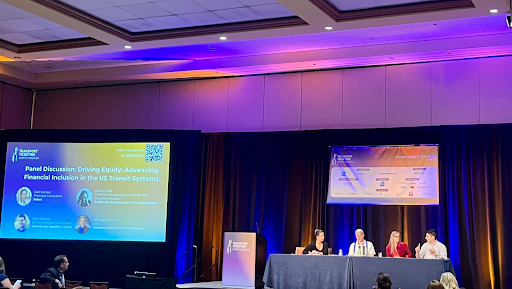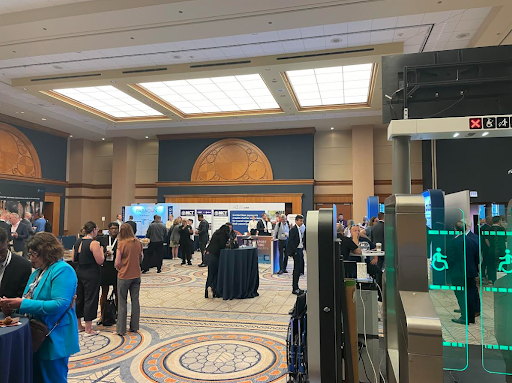Event Recap: Transport Ticketing North America 2025
By Shared-Use Mobility Center
Jul 15, 2025
Introduction
As transit payment systems constantly advance and evolve, agencies around the country are exploring how innovative fare technologies, mechanisms, and policies can be transformative tools to make transportation more accessible, more user-friendly, and more affordable. In June 2025, nearly 400 industry experts from transit agencies, software providers, equipment manufacturers, and nonprofits gathered in Chicago, IL for the Transport Ticketing North American conference. This two-day event showcased innovative technologies related to fare collection and payment integration, and allowed attendees to network and learn from each other about new developments in the transportation technology space.
Hani Shamat (Senior Program Coordinator), Abby Mader (Program Associate) and Francesca Lewis (Program Associate), represented the Shared-Use Mobility Center (SUMC) at the conference.
Hani Shamat (SUMC), participated on a panel entitled Driving Equity: Advancing Financial Inclusion in the US Transit Systems. The panel, moderated by Calli Cenizal (Rebel), included Gillian Gillett (California Department of Transportation) and Michael Kohlman (Monterey-Salinas Transit District), covered how new transit payment systems can be leveraged to make transportation more accessible for unbanked and underbanked riders. Panelists also discussed misconceptions about underbanked transit riders, barriers to uptake of these technologies, issues with verifying eligibility for discounted fares, and other problems the industry has yet to solve.

A few key takeaways from the conference
New payment technologies can make travel more integrated and more seamless.
Many sessions highlighted the different ways that fare payment technologies can support transit Many sessions highlighted the different ways that fare payment technologies can support transit integration. A panel discussion on the adoption of mobile ticketing and digital wallets showcased how these payment methods have transformed the way that riders use transit, particularly how they can open the door for seamless transfers and the integration of different modes. Additionally, presentations on implementing open payments in London, Toronto, and various cities in California noted the enhancements to rider experience. One session highlighted the Massachusetts Bay Transportation Authority’s (MBTA) recent implementation of open-loop payments, presented along with an update from Keolis on its progress with fare gate installations at select MBTA commuter rail stations.
Financial inclusion is key to accessible transit systems. New payment technologies can help.
Several panel discussions brought practitioners together to explore aspects of financial inclusion, with a focus on utilizing mobile ticketing systems to improve accessibility and address the digital divide by ensuring mobile ticketing solutions serve all passengers, including those without smartphones. A panel discussion explored the duality of mobile ticketing as a revolution or barrier to access. The discussion covered the benefits and challenges of mobile ticketing in public transit, with insights from NEORide and New Jersey Transit. Another conversation focused on simplifying discount fare eligibility processes to reduce administrative burdens for riders and agencies. Speakers discussed strategies that supported the eligibility process of reduced fare programs such as the role of partnerships and automated verification methods that support scalable programs.
Thoughtful data utilization can help expand transit access.
Data utilization, collection, and analysis were at the forefront of discussions among panelists and vendors. These experts emphasized how mobile apps and fare collection are helping to expand transit access and reduce barriers to entry, specifically for riders who do not use traditional forms of banking, tourists, and those moving between systems. Fare collection companies like Cubic and Conduent Transportation showcased integrated fare solutions that support a seamless rider experience, and representatives from transit agencies and credit card companies highlighted the growing role of open-loop payments in creating user-friendly and interoperable systems in sessions such as UX & Modern Data Architecture and the Fireside Chat: Future-Proofing Transit in Chicagoland.
On a local level, the Chicago Transit Authority (CTA), and its fare collection platform, Ventra, were featured as a leading example of how cities can leverage open data systems and thus the data that comes with it, for data-driven solutions in planning and implementation. From a passenger perspective, Ventra operates as the region’s unified platform that displays all arrival and departure times, as well as a way to reload fares on the go. From the planning perspective, data is gathered when a user taps into the metro system, providing valuable information on key destinations and transfers, which is used for service planning down the line. While this sentiment isn’t unique to Chicago, Chicago-based vendors and panelists gave unique insights about the specifics of data utilization across the Chicago region.

Conclusion
Fare collection technologies are key pieces of transit operations, and the ticketing industry is large and complex. For this reason, knowledge sharing is invaluable for moving the industry forward. The Transport Ticketing North America conference brought together transit agencies, consultants, technology vendors, and other industry experts to share ideas and learn from each other in person.
To stay up to date on details of upcoming events and trends in the mobility industry, subscribe to SUMC’s Mobility Hub Newsletter.